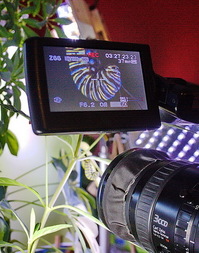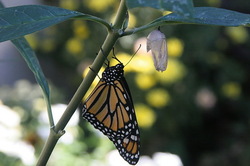 Intelligent Design
Intelligent Design
The Caterpillars Who Came to Dinner (and Lunch and Breakfast): An Interview with Lad Allen, Director of Metamorphosis
In film, it’s the final cut that counts. Crazy things can go on outside the viewfinder as long as the finished product looks good. Nobody knows that better than director Lad Allen, producer at Illustra Media.
 While filming his latest documentary, Metamorphosis, he faced some challenges that tested his patience, but ended up being extremely rewarding. We asked him to describe some of those behind-the-scenes adventures.
While filming his latest documentary, Metamorphosis, he faced some challenges that tested his patience, but ended up being extremely rewarding. We asked him to describe some of those behind-the-scenes adventures.
Describe what it was like to film all these magnificent butterflies.
Let me begin my reciting one of the fundamental rules of filmmaking: Unless it is absolutely necessary, NEVER work with animals. The reason is simple. Animals (especially insects) are usually terrible at taking direction! They don’t do what you want them to do, when you what them to do it. But, sometimes, the demands of a production force you to dive headfirst into unpredictable waters.
Why were butterflies so challenging to film?
A significant part of Metamorphosis deals with the butterfly’s extraordinary life-cycle. One of our objectives was to capture every facet of it on tape. Egg hatching…the rapid growth of the caterpillar…molting…the transformation of caterpillar into chrysalis…the emergence of a butterfly. It’s all spectacular stuff. But you never know exactly when any of it is going to occur. It quickly became obvious that the only way to get the job done was to have 24/7 access to our “stars” as they developed from egg to mature insect. And, the only way to do that was to set up a film studio….in the family room of our house.
No kidding, you adopted butterflies and turned your family room into a nursery?
First, I contacted an organization called the Monarch Program. They study and raise Monarch butterflies. I drove down to their facility and picked up eight new eggs (each about the size of a pinhead), and five milkweed plants — the only food their caterpillars will eat. When I got home, I walked in the door — eggs and plants in hand — and exclaimed to my wife, Joni,  “Guess what we’re going to do for the next month?” Fortunately, Joni grew up on a dairy farm. She misses raising livestock and crops. To my relief, she actually seemed pretty excited.
“Guess what we’re going to do for the next month?” Fortunately, Joni grew up on a dairy farm. She misses raising livestock and crops. To my relief, she actually seemed pretty excited.
How do you go about filming butterfly eggs hatching at home?
I set up the gear in the corner of our family room: lights, camera, tripod, macro-lenses, plants. Then, I waited six days for the eggs to mature. Several nights, I woke up at midnight and 3 AM to check on the eggs. When the big day finally came, it was a three-ring circus. After waiting for nearly a week, all of the eggs hatched within one hour! I was trying to guess which egg would hatch next, so I could get it into position for filming. While I was taping one egg, two more would crack (remember what I said about working with animals). When the smoke cleared, I had successfully filmed two hatchings — including the part where the microscopic caterpillar devoured the remains of the empty shell. As I would soon find out, that was only an appetizer.
In the film, Paul Nelson says that if an 8-pound baby gained weight at the same rate a caterpillar does, by the time it was full size it would weigh 24,000 pounds. How did you care for your ravenous octuplets?
For the next eight or nine days, the caterpillars did little else but eat and grow. They entered the world measuring about 1/32nd of an inch, and ended up almost as long as my index finger. We had to make two additional trips down to San Diego for more milkweed. Each morning, Joni and I got up early to take rollcall. We wanted to be certain everyone was present and accounted for. Some days, we’d be missing two or three of our “kids.” We’d start searching. Joni became so attached to the caterpillars that she gave them all names. One morning we found “Billy” climbing on the ceiling. “Fred” was inching his way up the leg of my tripod. Sometimes, they’d be crawling along the floor.
You’re lucky to have such an understanding wife, but how did you explain this to visitors?
When friends would visit, they’d want a tour. Everyone got a kick out of what was going on. One little boy asked if we always raised hungry worms in our house.
“No,” I replied, “but we raised four really hungry boys.”
What was it like to witness the transformation from caterpillar to butterfly up close and personal?
 We watched them hatching, eating, molting, crawling, forming their chrysalises, and emerging as butterflies eight glorious times. Through it all, we never tired of observing the seemingly miraculous process of metamorphosis. A caterpillar looks nothing like a butterfly. Yet, in a matter of weeks, it transforms into a beautiful winged insect. Science is still trying to understand the process. It’s sometimes referred to as “butterfly magic.” I agree.
We watched them hatching, eating, molting, crawling, forming their chrysalises, and emerging as butterflies eight glorious times. Through it all, we never tired of observing the seemingly miraculous process of metamorphosis. A caterpillar looks nothing like a butterfly. Yet, in a matter of weeks, it transforms into a beautiful winged insect. Science is still trying to understand the process. It’s sometimes referred to as “butterfly magic.” I agree.
I assume you don’t still have them flying around your family room, laying more eggs.
On Sunday, November 7, or last year, we took our final Monarch into the back yard and released him into the world. Joni shed a tear as “Billy” flew away. I have to admit that I got a little misty-eyed, myself. I never imagined I could become emotionally attached to an insect.
________________________
 To learn more about butterflies and the evidence they reveal for intelligent design, visit Metamorphosisthefilm.com, where you can watch the trailer and order this outstanding film, now available in both DVD and Blu-Ray formats. While you’re there, be sure to download the free companion e-book, Metamorphosis: The Case for Intelligent Design in a Chrysalis, edited by David Klinghoffer, a beautiful and informative resource to enhance your appreciation of butterflies.
To learn more about butterflies and the evidence they reveal for intelligent design, visit Metamorphosisthefilm.com, where you can watch the trailer and order this outstanding film, now available in both DVD and Blu-Ray formats. While you’re there, be sure to download the free companion e-book, Metamorphosis: The Case for Intelligent Design in a Chrysalis, edited by David Klinghoffer, a beautiful and informative resource to enhance your appreciation of butterflies.
